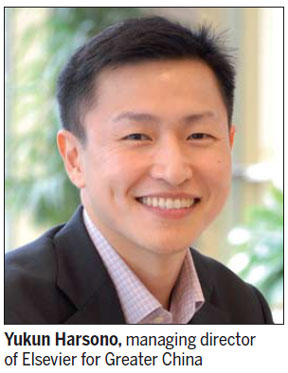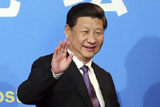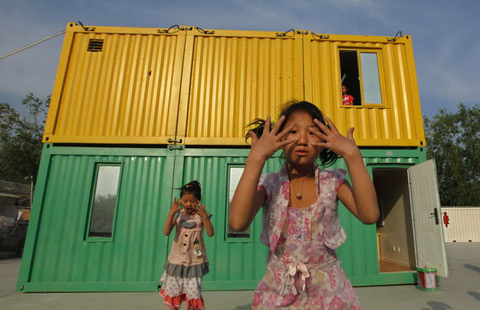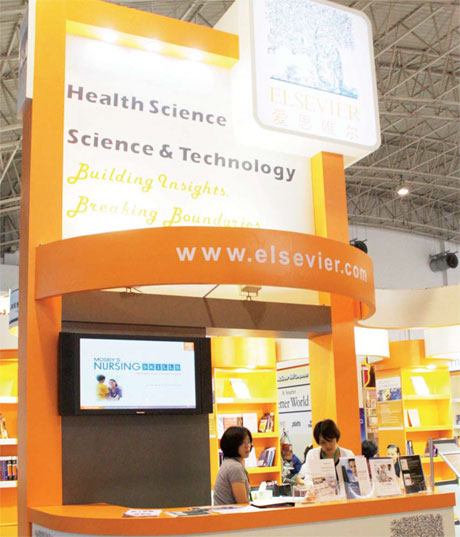Cash flows from fount of wisdom
Updated: 2014-03-21 08:14
By Liu Lu (China Daily Europe)
|
|||||||||||
|
Elsevier's booth at the 17th Beijing International Book Fair. The academic publishing company considers China's uniqueness in formulating its growth strategy. Provided to China Daily |
But in China there are areas where scientific research needs to be improved
A bearded old man in robes picks fruit from what could be a tree of knowledge. Hanging from the branches, to his left, is a banner with the Latin inscription "Non solus" (not alone).
Elsevier BV, the academic publishing company which has this image as its trademark, is not exactly alone in its sales endeavors in China, and sometimes the competition is akin to a war of attrition.
"We have seen our competitors in China come and go," says Yukun Harsono, managing director, greater China, for Elsevier, which sells scientific, technical and medical information products and services, and which has offices in 24 countries. It works closely with experts in science and health to publish more than 2,000 journals and about 20,000 books that serve more than 30 million scientists, students and health and information professionals worldwide.
"A lot of international publishers only see China as a big sales destination, a place where they can sell more of their products from other countries," Harsono says.
"As a result, they tend to struggle to be successful in China, because they do not have a learning mindset and are impatient for success.
"But we are different. We tend to be more open to the local culture and spend a lot of time understanding how the Chinese market operates, and we take into account China's uniqueness in formulating our growth strategy."
Apart from being open-minded, Harsono says, another key to success for international publishers in China is to know how to make the most of their competitive advantage.
"We know what we are good at, and we also know where we do not have much strength. So we tend to be quite selective about what we want to do, and we don't try to do everything. So I think it is that balance that allows us to continue to grow in a market like China."
Elsevier is part of Reed Elsevier, which has headquarters in London and Amsterdam, and whose revenue last year was 6.04 billion pounds ( 7.12 billion euros), 1 percent less than the year before. Elsevier's revenue accounted for a little more than a third of the Elsevier Reed total.
Elsevier is said to have introduced the first foreign scientific database in China, and that has helped make it by far the most successful foreign publisher in the country.

It says it published 28 percent of all Chinese-authored scientific journal articles in 2012. Between 2000 and 2013, it says, it published 12 million research articles, 25 percent of the world total and accessible to Chinese researchers on its ScienceDirect database.
Over those 13 years, Elsevier published 260,000 Chinese-authored articles, which were downloaded more than 400 million times.
Harsono says Elsevier has been trying to redress an imbalance in the fields that Chinese researchers excel in.
"Chinese researchers tend to be stronger in certain subject fields, including mathematics, engineering, physical sciences and computer science, which are the subjects from which I see more output from Chinese researchers, and increasing quality. But they are less strong compared with their international peers in the humanities, clinical science and medical sciences."
To obtain works from more researchers in China, Elsevier has brought together more than 600 Chinese editors and 1,700 eminent Chinese scientists to serve on Elsevier's journal editorial board to better support and represent the growing number of authors and articles submitted in China, Harsono says.
However, he says, the quality of much of the research needs improving.
"We have seen rapid growth in research output from China. We want more content from China, but sometimes the quality of the research means it is not ready to be published. So sometimes there is an interesting tradeoff for us. We end up having a higher rejection rate in China for our journals, and having fewer articles from China compared with the rest of the world because of that."
The rejection rate of Elsevier's papers sourced from China could be as high as 80 percent compared with 60 percent of those from developed markets, he says.
"We need time for China to mature in terms of quality in particular subjects. So sometimes we do very basic things such as author workshops, training that helps people to get better in terms of doing their research and their papers. But the impact of what we do may only show in three or five years when we can actually publish those papers."
More frequent exchanges between Chinese and overseas researchers and scientists is a good way to improve the quality of what is on offer, Harsono says, and Elsevier is working to increase collaboration.
"I have noticed that Chinese researchers tend to be a little more reserved. When you go to conferences they tend to spend more time listening. They are not as good as their overseas counterparts in networking, but research is a very collaborative people-based activity."
International collaboration helps improve the quality of research papers and means they are more likely to have a larger readership, he says.
"If you do the paper on your own, you are published as a single author. The citation impact is not so high. But when you do something with overseas partners, it increases the citation frequency of that article almost 250 percent."
Seeing the obvious improvement in quality through international collaboration, more Chinese researchers have been encouraged to study abroad, some paying their own way, but many more with government backing, Harsono says.
"An interesting thing is that for Chinese researchers who have gone abroad and come back, their research productivity is significantly higher than those who have mostly stayed in China, and the quality of their research output is higher."
Elsevier helps find opportunities for research collaboration between universities or research institutes in China and elsewhere and offers a platform to bridge them.
"Elsevier currently collaborates with about 100 partner institutions in China on scholarly publishing. We also provide them with insight into their research strength and tell them where we think there are research collaboration opportunities."
Harsono says that when foreign academic publishers explore the Chinese market they should not overlook the big differences between academic institutions in the country's east and west.
"We know that a lot of the research intensity is concentrated in key cities like Beijing and Shanghai. Our business has historically been concentrated in these areas. But China wants to reduce the disparity. There are smaller institutions that it wants to help upgrade and become more competitive in research.
"We have been engaged with the Chinese government and are working on a go-west strategy, where we actually create our offering based on content that will really meet the needs of these smaller institutions in the western part of China."
As the number of researchers has grown, and China's spending on R&D has increased, Harsono says he is very confident in Elsevier's prospects in China.
"The Chinese government is committed to shifting the nation's economic base from labor-intensive, export-led and manufacturing-based to one that is more knowledge-based, so there is more need for information and education and that will increase demand for our solutions. That's a good trend for us."
liulu@chinadaily.com.cn
(China Daily European Weekly 03/21/2014 page10)
Today's Top News
Israeli court convicts ex-PM Olmert in bribery case
Kerry in Israel attempting to salvage peace talks
We should join hands, Xi tells EU
China calls for calm on Koreas
Urgent hunt for black box
Ukraine sees Russian troop pullback
Russian PM Medvedev visits Crimea
DPRK, ROK exchange artillery fire
Hot Topics
Lunar probe , China growth forecasts, Emission rules get tougher, China seen through 'colored lens', International board,
Editor's Picks

|

|

|

|

|

|






